
Rail Pass in hand on train platform Photo by 戸山 神奈 on Unsplash
Why I Left Tokyo for a Day
Some mornings in Tokyo, I wake up and feel like I need a different kind of energy. Don't get me wrong - I love this city. After living here for eight years, I know which train car gets me closest to the exit, where to find the best coffee at 6 am, and how to navigate Shibuya crossing without breaking a sweat. But sometimes, that familiarity becomes a comfortable cage.
That's when I remember the fun Tokyo to Osaka trips I have done. It's only three hours away by bullet train and is one of my favorite Tokyo tour options. The thing about living in Tokyo is that you can get so caught up in the daily rhythm that you forget how easy it is to completely change your scenery. Osaka tours from Tokyo aren't just doable; they're super quick on the bullet train and practically therapeutic.
The decision usually hits me around Thursday afternoon. I'll be walking through Shinjuku, dodging the usual crowds, when I suddenly crave takoyaki that wasn't made for tourists. Authentic takoyaki, from a guy who's been doing it for thirty years and doesn't speak English. That's when I know it's time to escape south.
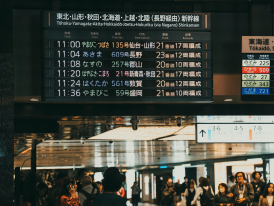
Platform announcement boards at Tokyo Station showing Shinkansen departures Photo by G N Pexels
The Shinkansen: My Bullet Train Ritual
I always catch the 7:06 am Hikari bullet train from Tokyo Station. Not because it's the fastest option - the Nozomi is quicker - but because the Hikari has this sweet spot between efficiency and contemplation. Plus, if you're using a Japan Rail Pass, the Nozomi isn't covered anyway.
My ritual starts at the kiosk inside the station. I grab a coffee - the Boss brand in a can, nothing fancy, and maybe some onigiri if I skipped breakfast. The beauty of the Shinkansen isn't just the speed; it's the forced meditation. You're committed to this journey for the next two hours and forty-five minutes.
On clear days, Mount Fuji appears around Kozu, and even after all these trips, I still look up from my phone. There's something about seeing Fuji that makes the whole adventure feel official. Like I'm really leaving Tokyo behind, not just changing neighborhoods.
A Note on Osaka Airports
While we won't be using airports during this trip, two Osaka airports are worth mentioning. Kansai International Airport (KIX), built on an artificial island in Osaka Bay, serves as the primary international gateway to the Kansai region and offers direct access to Osaka city center via express trains in just 45 minutes. In comparison, Tokyo's Narita Airport is located much farther from Osaka.
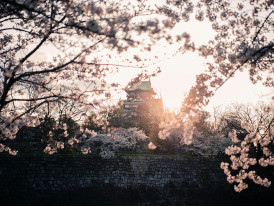
Spring cherry blossoms at Osaka Castle Photo by Satoshi Hirayama: Pexels
First Stop: Shin-Osaka Station to Osaka Castle
Osaka Castle serves as my psychological reset button on any Osaka trip. After the confined energy of the train, walking through Osaka Castle Park feels like stretching after a long flight. The thing about visiting Osaka Castle early in the morning is that you catch it before the Osaka tours and tour groups arrive. Around 9 am, you'll share the space mostly with joggers and elderly folks doing tai chi.
The moat reflects the castle's white walls, and if you're lucky enough to visit during cherry blossom season, the contrast is almost absurd in its perfection. I don't always go inside the castle museum; sometimes the exterior and grounds are enough. What matters is taking fifteen minutes to sit somewhere quiet and let Tokyo's urgency drain out of my system.
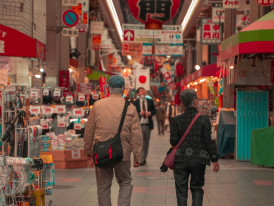
Exploring colorful stalls at Kuromon Market: Photo by Yuki: https://www.pexels.com/photo/woman-and-man-walking-on-bazaar-7695090/
Kuromon Market: A Street Food Wonderland
From Osaka Castle, Kuromon Ichiba Market is a short subway ride away. This is where my trip to Osaka from Tokyo really begins to pay dividends. Tokyo has incredible food, but Tokyo food often comes with Tokyo prices and Tokyo crowds. Kuromon Market operates on an entirely different frequency.
What I love about Kuromon compared to Tokyo's food markets is the lack of pretense. Vendors here aren't performing for Instagram or catering to food bloggers. They're feeding people who work in the neighborhood and happen to be hungry.
My usual route starts with takoyaki from Daruma, where the old man behind the counter moves with the efficiency of someone who's made thousands of these octopus balls. This authentic experience is exactly what most Osaka tours miss.
Next, I'll grab some fresh fruit. The strawberries in Kuromon are ridiculously sweet and half the price you'd pay in Tokyo's department store basements. Sometimes, I'll pick up wagyu beef sashimi, thin slices of raw beef that sound strange until you try them, or fresh uni if it looks perfect that day.

Osaka subway signage Photo by Enric Cruz López Pexels
Getting Around Osaka: Metro vs Walking
Osaka's subway system makes sense in a way that Tokyo's labyrinthine network doesn't always. The Midosuji Line runs north-south like a spine, connecting most places you'd want to visit in a day. The Chuo Line runs east-west from Osaka Station. That's it for tourist purposes and is used in many Osaka tour packages.
But honestly, I prefer walking in Osaka when the weather's decent. The city reveals itself differently at street level. From Kuromon Market to the Namba district, it's about a fifteen-minute walk through neighborhoods that shift character every few blocks. And, if you're lucky enough, you might even spot a traditional Ryokan inn tucked away in quieter residential neighborhoods, offering a peaceful contrast to the city's bustling commercial districts.
Navigating Osaka Efficiently
The key to navigating Osaka efficiently is understanding that it's not trying to impress you the way Tokyo sometimes does. Streets here follow practical logic rather than aesthetic principles. Once you accept that, getting around becomes intuitive.
Three Key Osaka Train Stations
In case you're wondering, the difference between Osaka and Shin-Osaka station is that the latter is where the Shinkansen stops. Osaka Station is the main hub for all local commuter trains and subways, and is much busier than Shin-Osaka Station. You also get JR Osaka Station, which serves as a central hub. You can also find convenient connections to multiple train and metro lines, along with bus transportation, during Osaka tours.

Dotonbori at twilight. Photo by Satoshi Hirayama Pexels
A Walk Through Namba: Neon and Nostalgia
Namba is where Osaka shows off, but in a completely different way than Tokyo's flashy districts. Where Shibuya or Harajuku feels designed for maximum impact, Namba feels like it evolved organically over decades. The neon signs and crowded streets serve the locals first, tourists second.
The Dotonbori canal runs through the heart of Namba, lined with restaurants whose signs have become iconic: the giant mechanical crab, the enormous blowfish, the rotating sushi chef. These aren't tourist attractions pretending to be authentic local spots; they're authentic local spots that happen to attract tourists.
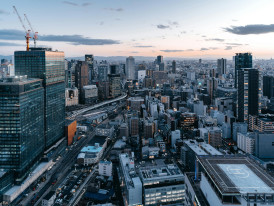
Cityscape view from Umeda Sky Building Photo by Patrick Kua: Pexels
One Last Look: Sunset from Umeda Sky Building
As my day in Osaka winds down, I have a choice: head straight back to Tokyo, or catch the sunset from somewhere with a view. The Umeda Sky Building wins almost every time.
The building looks like something from a 1970s sci-fi movie: two towers connected by a floating observatory at the top. At sunset, Osaka spreads out below in all directions, the urban landscape painted in warm light. From up here, you can see how different Osaka is from Tokyo. Where Tokyo builds upward in concentrated clusters, Osaka spreads more evenly.
I usually spend about thirty minutes up here, letting the day settle into memory. This is when I start thinking about the train ride home from Osaka Station, but I'm not in a rush. The last comfortable Shinkansen back to Tokyo doesn't leave until after 9 pm.
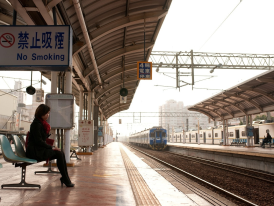
Waiting to return to Tokyo Image by Fang_Y_M from Pixabay
Back to Tokyo: What This Day Trip Gave Me
The journey back to Tokyo always feels different from the morning trip south. I'm carrying the taste of authentic takoyaki, the memory of conversations with strangers, and a subtle shift in perspective that comes from stepping outside your daily routine.
On the train, after one of my favorite Tokyo tours, I usually review photos on my phone and realize I didn't take many. That's a good sign. When you're constantly documenting an experience, you're not fully living it. My best trips to Osaka are the ones where I forget to perform the role of tourist and just exist as someone exploring a neighboring city. By the time Tokyo's Station appears outside the window, I'm ready to be home. But I'm also already thinking about when I'll make this trip again.
What Makes This Different from Typical Tours
Formal tours of Osaka try to show you the greatest hits in the most efficient order possible. This city rewards wandering. It rewards stopping to watch an elderly man make imagawayaki with the same technique he's used for forty years. The Osaka experiences that stick with you aren't the ones you can describe easily to friends back home.
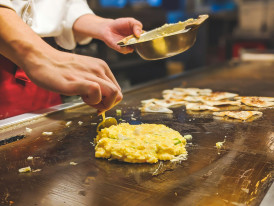
Chef preparing okonomiyaki Photo by Daniel Hooper
Food Philosophy: Why Osaka Tastes Different
Osaka calls itself "Japan's kitchen." After dozens of these trips, I understand why. It's not just that the food is good; Tokyo has incredible food too. It's that food in Osaka serves a different social function. In Tokyo, dining often feels like performance art. In Osaka, food is fuel for conversation, community, and the simple pleasure of eating something delicious.
Best Street Foods in Osaka
Osaka's street food scene revolves around three legendary dishes that define the city's culinary identity. Look for street foods like Takoyaki, the city's most iconic creation; Okonomiyaki, often called "Japanese pizza; and, of course, Kushikatsu, which represents Osaka's working-class soul.
Practical Time Management
A realistic day trip to Osaka from Tokyo gives you about eight hours in the city if you catch early trains and don't mind returning after 9 pm. Focus on one or two neighborhoods rather than trying to cover the entire city. Namba and the surrounding areas offer the densest concentration of food, culture, and walkable experiences.
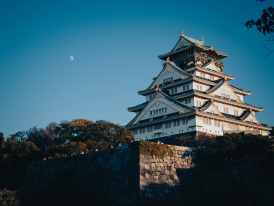
Osaka Castle with clear skies Photo by Thành Văn Đình Pexels
Best Times to Visit
I've made this trip in every season. Spring brings cherry blossoms around Osaka Castle and comfortable walking weather. Summer can be brutally humid, but the energy in places like Dotonbori feels more intense. Fall provides perfect weather for walking and the best food experiences. Winter trips mean fewer crowds and the chance to warm up in cozy ramen shops.
The Journey Home
The train ride back to Tokyo provides natural transition time between experiences. Sometimes, I'll write notes on my phone, not for any blog or social media post, but just to capture impressions while they're fresh: the taste of that perfect bowl of ramen, the sound of Kansai dialect in conversation, the way evening light looked reflecting off the Dotonbori canal.
By the time I'm walking through the station toward the Yamanote Line, I'm ready to be home. But I'm also carrying a subtle reminder that home exists within a larger, more varied world. This isn't a tour - it's your Osaka story, waiting to unfold just three hours south of wherever you woke up this morning.
Yuji Ito has been exploring Japan's hidden corners and obvious pleasures for over a decade. When he's not discovering new ramen shops or getting lost in Tokyo's back alleys, he writes about authentic travel experiences beyond the typical tourist trail.

